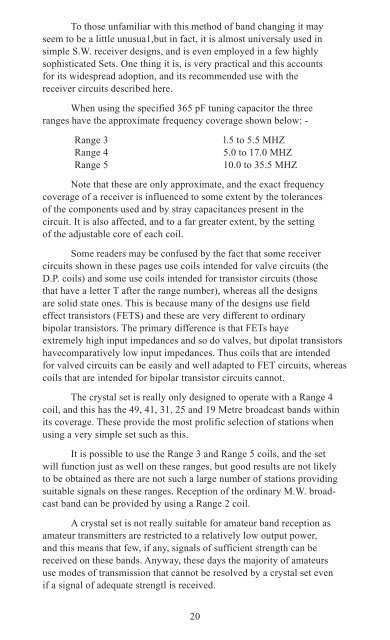Solid State Shortwave Receivers For Beginners - The Listeners Guide
Solid State Shortwave Receivers For Beginners - The Listeners Guide
Solid State Shortwave Receivers For Beginners - The Listeners Guide
Create successful ePaper yourself
Turn your PDF publications into a flip-book with our unique Google optimized e-Paper software.
To those unfamiliar with this method of band changing it may<br />
seem to be a little unusua1,but in fact, it is almost universaly used in<br />
simple S.W. receiver designs, and is even employed in a few highly<br />
sophisticated Sets. One thing it is, is very practical and this accounts<br />
for its widespread adoption, and its recommended use with the<br />
receiver circuits described here.<br />
When using the specified 365 pF tuning capacitor the three<br />
ranges have the approximate frequency coverage shown below: -<br />
Range 3 l.5 to 5.5 MHZ<br />
Range 4 5.0 to 17.0 MHZ<br />
Range 5 10.0 to 35.5 MHZ<br />
Note that these are only approximate, and the exact frequency<br />
coverage of a receiver is influenced to some extent by the tolerances<br />
of the components used and by stray capacitances present in the<br />
circuit. It is also affected, and to a far greater extent, by the setting<br />
of the adjustable core of each coil.<br />
Some readers may be confused by the fact that some receiver<br />
circuits shown in these pages use coils intended for valve circuits (the<br />
D.P. coils) and some use coils intended for transistor circuits (those<br />
that have a letter T after the range number), whereas all the designs<br />
are solid state ones. This is because many of the designs use field<br />
effect transistors (FETS) and these are very different to ordinary<br />
bipolar transistors. <strong>The</strong> primary difference is that FETs haye<br />
extremely high input impedances and so do valves, but dipolat transistors<br />
havecomparatively low input impedances. Thus coils that are intended<br />
for valved circuits can be easily and well adapted to FET circuits, whereas<br />
coils that are intended for bipolar transistor circuits cannot.<br />
<strong>The</strong> crystal set is really only designed to operate with a Range 4<br />
coil, and this has the 49, 41, 31, 25 and 19 Metre broadcast bands within<br />
its coverage. <strong>The</strong>se provide the most prolific selection of stations when<br />
using a very simple set such as this.<br />
It is possible to use the Range 3 and Range 5 coils, and the set<br />
will function just as well on these ranges, but good results are not likely<br />
to be obtained as there are not such a large number of stations providing<br />
suitable signals on these ranges. Reception of the ordinary M.W. broadcast<br />
band can be provided by using a Range 2 coil.<br />
A crystal set is not really suitable for amateur band reception as<br />
amateur transmitters are restricted to a relatively low output power,<br />
and this means that few, if any, signals of sufficient strength can be<br />
received on these bands. Anyway, these days the majority of amateurs<br />
use modes of transmission that cannot be resolved by a crystal set even<br />
if a signal of adequate strengtl is received.<br />
20

















